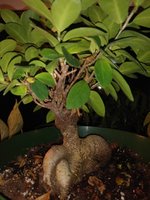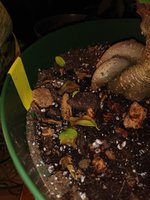ducreamious
Sapling
I got a ginseng ficus a little over a month ago, and ever since I got it's been losing leaves. fast.
a few every day. the leaves yellow and then fall off. They don't curl up and are even mostly green when they fall off. They do not go limp either. I know they lose leaves easily from condition changes but it's losing a lot of leaves and it's been a while. It's thinning out leaves in the middle (I'm assuming because of less light) but I have it at a west facing window which isn't too bad. I just got a mirror today in hopes of adding more light.
2 weeks after I got it, I repotted it to put it in a pot with drainage because I thought that might be it. that's not it. I water it about every week.
I tried changing humidity but thats not it either.
There are also tiny white bugs in the new soil. It's odd because the soil was brand new. There are also a few fungal gnats but I squish them when I see them (there's not too many).
What should I do? Do I not change anything and just hope it recovers by itself?
a few every day. the leaves yellow and then fall off. They don't curl up and are even mostly green when they fall off. They do not go limp either. I know they lose leaves easily from condition changes but it's losing a lot of leaves and it's been a while. It's thinning out leaves in the middle (I'm assuming because of less light) but I have it at a west facing window which isn't too bad. I just got a mirror today in hopes of adding more light.
2 weeks after I got it, I repotted it to put it in a pot with drainage because I thought that might be it. that's not it. I water it about every week.
I tried changing humidity but thats not it either.
There are also tiny white bugs in the new soil. It's odd because the soil was brand new. There are also a few fungal gnats but I squish them when I see them (there's not too many).
What should I do? Do I not change anything and just hope it recovers by itself?



